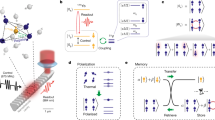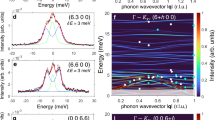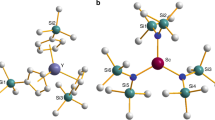Abstract
Spins in molecules are particularly attractive targets for next-generation quantum technologies, enabling chemically programmable qubits and potential for scale-up via self-assembly. Here we report the observation of one of the largest hyperfine interactions for a molecular system, Aiso = 3,467 ± 50 MHz, as well as a very large associated clock transition. This is achieved through chemical control of the degree of s-orbital mixing into the spin-bearing d orbital associated with a series of spin-½ La(II) and Lu(II) complexes. Increased s-orbital character reduces spin–orbit coupling and enhances the electron–nuclear Fermi contact interaction. Both outcomes are advantageous for quantum applications. The former reduces spin–lattice relaxation, and the latter maximizes the hyperfine interaction, which, in turn, generates a 9-GHz clock transition, leading to an increase in phase memory time from 1.0 ± 0.4 to 12 ± 1 μs for one of the Lu(II) complexes. These findings suggest strategies for the development of molecular quantum technologies, akin to trapped ion systems.

This is a preview of subscription content, access via your institution
Access options
Access Nature and 54 other Nature Portfolio journals
Get Nature+, our best-value online-access subscription
$29.99 / 30 days
cancel any time
Subscribe to this journal
Receive 12 print issues and online access
$259.00 per year
only $21.58 per issue
Buy this article
- Purchase on Springer Link
- Instant access to full article PDF
Prices may be subject to local taxes which are calculated during checkout





Similar content being viewed by others
Data availability
All data that support the findings of this study are available via the Open Science Framework (OSF, https://osf.io/jr3dq/) with the identifier https://doi.org/10.17605/OSF.IO/JR3DQ55. These data include the EPR results presented in the main paper, the optimized coordinate files from the computational studies, as well as the X-ray, 1H/13C NMR, infrared and UV–vis spectra in the Supplementary Information. The available crystallographic data have also been deposited at the Cambridge Crystallographic Data Centre under the following deposition numbers: [K(crypt)]+[LuII(OAr*)3]−, compound 4, CCDC 2074946 and LuIII(OAr*)3, CCDC 2074947. Copies of the data can be obtained free of charge via https://www.ccdc.cam.ac.uk/structures/. Source data are provided with this paper.
Code availability
All computer codes employed in this study are available in the cited references.
References
Arute, F. et al. Quantum supremacy using a programmable superconducting processor. Nature 574, 505–510 (2019).
Devoret, M. H. & Schoelkopf, R. J. Superconducting circuits for quantum information: an outlook. Science 339, 1169–1174 (2013).
Wright, K. et al. Benchmarking an 11-qubit quantum computer. Nat. Commun. 10, 5464 (2019).
Carolan, J. et al. Universal linear optics. Science 349, 711–716 (2015).
Das Sarma, S., Freedman, M. & Nayak, C. Majorana zero modes and topological quantum computation. Npj Quantum Inf. 1, 15001 (2015).
Loss, D. & DiVincenzo, D. P. Quantum computation with quantum dots. Phys. Rev. A 57, 120–126 (1998).
Kane, B. E. A silicon-based nuclear spin quantum computer. Nature 393, 133–137 (1998).
Yang, K. et al. Coherent spin manipulation of individual atoms on a surface. Science 366, 509–512 (2019).
Thiele, S. et al. Electrically driven nuclear spin resonance in single-molecule magnets. Science 344, 1135–1138 (2014).
Gaita‐Ariño, A., Luis, F., Hill, S. & Coronado, E. Molecular spins for quantum computation. Nat. Chem. 11, 301–309 (2019).
Schweiger, A. & Jeschke, G. Principles of Pulse Electron Paramagnetic Resonance (Oxford Univ. Press, 2001).
Nguyen, T. N. et al. Supramolecular aggregates of single-molecule magnets: exchange-biased quantum tunneling of magnetization in a rectangular [Mn3]4 tetramer. Chem. Sci. 7, 1156–1173 (2016).
Zadrozny, J. M., Niklas, J., Poluetkov, O. G. & Freedman, D. E. Millisecond coherence time in a tunable molecular electronic spin qubit. ACS Cent. Sci. 1, 488–492 (2015).
Shiddiq, M. et al. Enhancing coherence in molecular spin qubits via atomic clock transitions. Nature 531, 348–351 (2016).
Zadrozny, J. M., Gallagher, A. T., Harris, T. D. & Freedman, D. E. A porous array of clock qubits. J. Am. Chem. Soc. 139, 7089–7094, (2017).
Collett, C. A., Santini, P., Carretta, S. & Friedman, J. R. Constructing clock-transition-based two-qubit gates from dimers of molecular nanomagnets. Phys. Rev. Res. 2, 032037(R) (2020).
Giménez-Santamarina, S., Cardona-Serra, S., Clemente-Juan, J. M., Gaita-Ariño, A. & Coronado, E. Exploiting clock transitions for the chemical design of resilient molecular spin qubits. Chem. Sci. 11, 10718–10728 (2020).
Ghosh, S. et al. Multi-frequency EPR studies of a mononuclear holmium single-molecule magnet based on the polyoxometalate [Ho(W5O18)2]9−. Dalton Trans. 41, 13697–13704 (2012).
Miao, K. C. et al. Universal coherence protection in a solid-state spin qubit. Science 369, 1493–1497 (2020).
Hitchcock, P. B., Lappert, M. F., Maron, L. & Protchenko, A. V. Lanthanum does form stable molecular compounds in the +2 oxidation state. Angew. Chem. Int. Ed. 47, 1488–1491 (2008).
MacDonald, M. R., Bates, J. E., Ziller, J. W., Furche, F. & Evans, W. J. Completing the series of +2 ions for the lanthanide elements: synthesis of molecular complexes of Pr2+, Gd2+, Tb2+, and Lu2+. J. Am. Chem. Soc. 135, 9857–9868 (2013).
Evans, W. J. Tutorial on the role of cyclopentadienyl ligands in the discovery of molecular complexes of the rare-earth and actinide metals in new oxidation states. Organometallics 35, 3088–3100 (2016).
Ryan, A. J., Ziller, J. W. & Evans, W. J. The importance of the counter-cation in reductive rare-earth metal chemistry: 18-crown-6 instead of 2,2,2-cryptand allows isolation of [YII(NR2)3]1- and ynediolate and enediolate complexes from CO reactions. Chem. Sci. 11, 2006–2014 (2020).
Moehring, S. A. et al. Room-temperature stable Y(II) aryloxide: using steric saturation to kinetically stabilize Y(II) complexes. Inorg. Chem. 59, 3207–3214 (2020).
Woen, D. H. & Evans, W. J. Expanding the +2 oxidation state to the rare-earth metals, uranium and thorium in molecular complexes. Handbook on the Physics and Chemistry of the Rare Earths Including Actinides 50, 337–394 (2016).
Wolfowicz, G. et al. Atomic clock transitions in silicon-based spin qubits. Nat. Nanotechnol. 8, 561–564 (2013).
Ariciu, M.-A. et al. Engineering electronic structure to prolong relaxation times in molecular qubits by minimising orbital angular momentum. Nat. Commun. 10, 3330 (2019).
Anderson, D. M. et al. On the stability and bonding in bis(η-arene)lanthanide complexes. J. Chem. Soc. Chem. Commun. 1989, 53–55 (1989).
Knapp, C., Weiden, N. & Dinse, K.-P. EPR investigation of endofullerenes in solution. Appl. Phys. A 66, 249–255 (1998).
Schwamm, R. J. et al. Isolation and characterization of a bismuth(II) radical. Angew. Chem. Int. Ed. 54, 10630–10633 (2015).
Cutsail, G. E. III Applications of electron paramagnetic resonance spectroscopy to heavy main-group radicals. Dalton Trans. 49, 12128–12135 (2020).
Smith, R. L., Wysocki, A. L. & Park, K. Electrically tuned hyperfine spectrum in neutral Tb(II)(CpiPr5)2 single-molecule magnet. Phys. Chem. Chem. Phys. 22, 21793–21800 (2020).
Stoll, S. & Schweiger, A. EasySpin, a comprehensive software package for spectral simulation and analysis in EPR. J. Magn. Reson. 178, 42–55 (2006).
Stoll, S. & Goldfarb, D. EPR interactions—nuclear quadrupole couplings. eMagRes 6, 495–510 (2017).
Cruikshank, P. A. S. et al. A kilowatt pulsed 94-GHz electron paramagnetic resonance spectrometer with high concentration sensitivity, high instantaneous bandwidth and low dead time. Rev. Sci. Instrum. 80, 103102 (2009).
Schwindt, P. D. D. et al. Miniature trapped-ion frequency standard with 171Yb+. In Proc. 2015 Joint Conference of the IEEE International Frequency Control Symposium & the European Frequency and Time Forum 752–757 (IEEE, 2015); https://doi.org/10.1109/FCS.2015.7138951
Stone, N. J. Table of nuclear electric quadrupole moments. At. Data Nucl. Data Tables 111–112, 1–28 (2016).
Peng, D., Middendorf, N., Weigend, F. & Reiher, M. An efficient implementation of two-component relativistic exact-decoupling methods for large molecules. J. Chem. Phys. 138, 184105 (2013).
Visscher, L. & Dyall, K. G. Dirac–Fock atomic electronic structure calculations using different nuclear charge distributions. At. Data Nucl. Data Tables 67, 207–224 (1997).
Autschbach, J. & Ziegler, P. Nuclear spin-spin coupling constants from regular approximate relativistic density functional calculations. I. Formalism and scalar relativistic results for heavy metal compounds. J. Chem. Phys. 113, 936–947 (2000).
Reed, A. E., Weinstock, R. B. & Weinhold, F. Natural population analysis. J. Chem. Phys. 83, 735–746 (1985).
Pykkö, P. Relativistic effects in chemistry: more common than you thought. Ann. Rev. Phys. Chem. 63, 45–64 (2012).
Haiduke, R. L. A., da Silva, A. B. F. & Visscher, L. The nuclear electric quadrupole moment of lutetium from the molecular method. Chem. Phys. Lett. 445, 95–98 (2007).
van Lenthe, E. & Baerends, E. Density functional calculations of nuclear quadrupole coupling constants in the zero-order regular approximation for relativistic effects. J. Chem. Phys. 112, 8279–8292 (2000).
Schwerdtfeger, P., Pernpointner, M. & Laerdahl, J. K. The accuracy of current density functionals for the calculation of electric field gradients: a comparison with ab initio methods for HCl and CuCl. J. Chem. Phys. 111, 3357–3364 (1999).
Srebro, M. & Autschbach, J. Does a molecule-specific density functional give an accurate electron density? The challenging case of the CuCl electric field gradient. J. Phys. Chem. Lett. 3, 576–581 (2012).
Franzke, Y. J. & Yu, J. M. Hyperfine coupling constants in local exact two-component theory. J. Chem. Theory Comput. 18, 323−343 (2022).
Song, L. et al. Towards increased concentration sensitivity for continuous wave EPR investigations of spin-labeled biological macromolecules at high fields. J. Magn. Res. 265, 188–196 (2016).
EasySpin; https://easyspin.org
Staroverov, V. N., Scuseria, G. E., Tao, J. & Perdew, J. P. Comparative assessment of a new nonempirical density functional: molecules and hydrogen-bonded complexes. J. Chem. Phys. 119, 12129–12137 (2003).
Franzke, Y. J., Treß, R., Pazdera, T. M. & Weigend, F. Error-consistent segmented contracted all-electron relativistic basis sets of double- and triple-zeta quality for NMR shielding constants. Phys. Chem. Chem. Phys. 21, 16658–16664 (2019).
Franzke, Y. J., Middendorf, N. N. & Weigend, F. Efficient implementation of one- and two-component analytical energy gradients in exact two-component theory. J. Chem. Phys. 148, 104110 (2018).
Peng, D. & Reiher, M. J. Local relativistic exact decoupling. Chem. Phys. 136, 244108 (2012).
Balasubramani, S. G. et al. TURBOMOLE: modular program suite for ab initio quantum-chemical and condensed-matter simulations. J. Chem. Phys. 152, 184107 (2020).
Hill, S. et al. 9.2-GHz clock transition in a Lu(II) molecular spin qubit arising from a 3,467- MHz hyperfine interaction (OSF, 2021); https://doi.org/10.17605/OSF.IO/JR3DQ
Acknowledgements
We thank the US National Science Foundation (NSF; CHE-1855328 to W.J.E. and CHE-1800431 and CHE-2102568 to F.F.) and the Department of Energy (DE-SC0020260 to S.H.) for support of this research. Work performed at the NHMFL is supported by the NSF (DMR-1644779) and by the State of Florida. J.M.Y. acknowledges support of the NSF Graduate Research Fellowship Program (DGE-1839285). We also thank the Eddleman Quantum Institute for promoting this collaborative project.
Author information
Authors and Affiliations
Contributions
W.J.E., F.F. and S.H. conceived the research. J.R.K.W. and S.A.M. prepared the samples, S.H. and K.K. designed the experiments. K.K. performed the measurements. K.K. and S.H. analysed the EPR results, J.W.Z. performed the X-ray structural analysis. J.M.Y. and F.F. formulated and executed the computational analysis. All authors contributed to the writing of the manuscript.
Corresponding authors
Ethics declarations
Competing interests
The authors declare no competing interests.
Peer review
Peer review information
Nature Chemistry thanks the anonymous reviewers for their contribution to the peer review of this work.
Additional information
Publisher’s note Springer Nature remains neutral with regard to jurisdictional claims in published maps and institutional affiliations.
Extended data
Extended Data Fig. 1 EPR spectral lineshapes.
(a) Qualitative simulations of the ESE intensity patterns observed for compounds 2 and 4. The full spectra (in purple) were generated by summing individual hyperfine components – the eight colored curves above each summed spectrum, labeled according to the associated nuclear projection, mI. The asymmetric lineshapes of the individual components are dictated by the \(\overleftrightarrow g\)-tensor anisotropy and the spacing by the hyperfine and nuclear quadrupole interactions. These simulations capture the main features observed in the experimental spectra, particularly the staircase increase in intensity on the low-field side of the spectrum for 2. The pink oval highlights the region of the spectrum shown in (b). (b) Zoomed region of the experimental spectrum of 4, from Fig. 3c, showing the feature that is very sensitive to the NQI. Superimposed are simulations for different values of Qzz, from which the optimum value of 100 ± 20 MHz is deduced (Table 1). We note that the qualitative simulations in (a) do not explicitly take into account the NQI, whereas the exact simulations in (b) do; for further details, see Supplementary Information Section 3.
Extended Data Fig. 2 Parallel and perpendicular mode X-band simulations.
(a) Perpendicular mode simulations using parameters from Table 1, but with Qzz = 0. The important thing to note is the absence of the weakly allowed 8 → 10 resonance that is clearly seen in the experimental spectra (Fig. 4). (b) The 8 → 10 resonance appears upon inclusion of the NQI in the perpendicular mode simulations, with Qzz = 100 MHz correctly reproducing the relative intensities of the 8 → 9 and 8 → 10 resonances, which are only seen in the perpendicular mode simulations. (c) Parallel mode simulations with full parameterization in Table 1. A frequency dependent mixture of perpendicular and parallel simulations is needed for the simulations in Fig. 4 (see Methods). Although the units are arbitrary, the three panels are presented in the same absolute scale, that is, the simulations have not been rescaled.
Extended Data Fig. 3 Spin-lattice (T1) relaxation measurements for 4.
ESE saturation recovery measurements at 310 (a), 410 (b) and 720 mT (c); the frequency was 9.16 GHz and the temperature 5 K. T1 times deduced from exponential fits are displayed in each panel; the uncertainties correspond to the standard errors. See Supplementary Information Section 4 for further details.
Extended Data Fig. 4 Spin density calculations.
Contours of the spin density (blue) computed with DFT for compounds 2 (a), 3 (b), and 4 (c), plotted at a contour value of 0.005. Hydrogen atoms have been omitted. Color codes: Grey = C, Red = O, Brown = Si, Teal = N, Pink = Ln.
Extended Data Fig. 5 Ellipsoid plots of the nuclear quadrupole moment tensor.
Visualization of the quadrupole tensors arising from the Ln nucleus computed with DFT for compounds 4 (a), 3 (b), and 2 (c). Because η is small, the ellipsoids are effectively spheroidal in all three cases. Scaling factors, s, of 5.5 × 103, 5.5 × 103, and 1.65 × 104 were applied in (a), (b), and (c), respectively; see Supplementary Information Section 5 for further details. Hydrogen atoms were omitted for clarity. Color codes: Grey = C, Red = O, Tan = Si, Blue = N, Teal = Ln.
Extended Data Fig. 6 Synthesis of [K(crypt)][Lu(OAr*)3], 4.
Potassium reduction of Lu(OAr*)3 in the presence of 2.2.2-cryptand yields [K(crypt)][Lu(OAr*)3].
Supplementary information
Supplementary Information
Supplementary Figs. 1–7, Tables 1–14 and discussion of structural characterization, synthetic details, EPR simulations, T1 measurements, computational details and crystallography (including relevant references).
Supplementary Data 1
Crystallographic file for Lu(III)(OAr*)3, CCDC 2074947.
Supplementary Data 2
Crystallographic file for [K(crypt)][Lu(II)(OAr*)3]·3Et2O, compound 4, CCDC 2074946.
Source data
Source Data Fig. 1a
Source curves (x, y values); further details in file; note that the structure in Fig. 1b is provided as a separate ChemDraw file.
Source Data Fig. 1b
Image of molecule made in Mercury for part (b) of Fig. 1.
Source Data Fig. 2
Source curves (x, y values) for each panel of the figure, including resonance positions; further details in file.
Source Data Fig. 3
Source curves (x, y values) for each panel of the figure, including data and simulations; further details in file.
Source Data Fig. 4
Matrix for 2D color map in panel (a), together with data and simulations (x, y & error values) for each panel of the figure; further details in file.
Source Data Fig. 5
Source data points and curves (x, y & error values) for each panel of the figure; further details in file.
Source Data Extended Data Fig. 1
Source curves (x, y values) for each panel of the figure; further details in file.
Source Data Extended Data Fig. 2
Source curves (x, y values) for each panel of the figure; further details in file.
Source Data Extended Data Fig. 3
Source data points and curves (x, y values) for each panel of the figure; further details in file.
Source Data Extended Data Fig. 4
Optimized atomic xyz coordinates for the compounds studied with electronic structure calculations.
Source Data Extended Data Fig. 5
Optimized atomic xyz coordinates for the compounds studied with electronic structure calculations.
Rights and permissions
About this article
Cite this article
Kundu, K., White, J.R.K., Moehring, S.A. et al. A 9.2-GHz clock transition in a Lu(II) molecular spin qubit arising from a 3,467-MHz hyperfine interaction. Nat. Chem. 14, 392–397 (2022). https://doi.org/10.1038/s41557-022-00894-4
Received:
Accepted:
Published:
Issue Date:
DOI: https://doi.org/10.1038/s41557-022-00894-4
This article is cited by
-
Electron-nuclear decoupling at a spin clock transition
Communications Physics (2023)
-
High-Field EPR Investigation and Detailed Modeling of the Magnetoanisotropy Tensor of an Unusual Mixed-Valent MnIV2MnIII2MnII Cluster
Applied Magnetic Resonance (2023)
-
Electrical two-qubit gates within a pair of clock-qubit magnetic molecules
npj Quantum Information (2022)
-
Molecular spins clock in
Nature Chemistry (2022)
-
Contrasting behaviour under pressure reveals the reasons for pyramidalization in tris(amido)uranium(III) and tris(arylthiolate) uranium(III) molecules
Nature Communications (2022)



